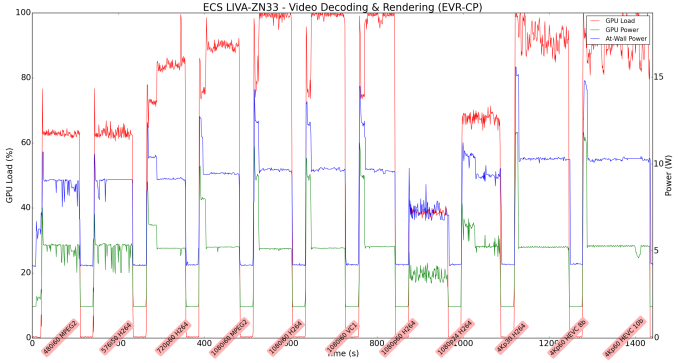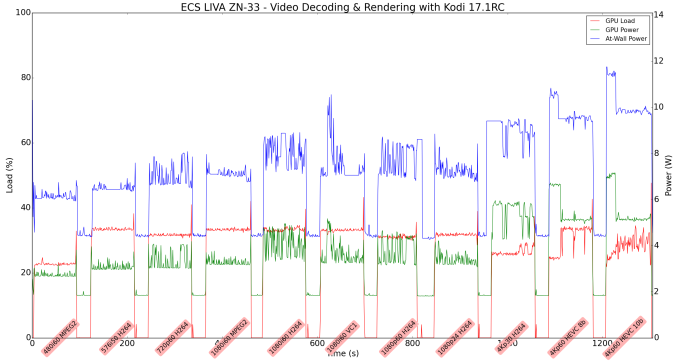ECS LIVA Z Fanless Dual-LAN Apollo Lake UCFF PC Review
by Ganesh T S on March 30, 2017 8:00 AM ESTHTPC Credentials
Given the fanless nature of the ECS LIVA Z and the presence of Intel HD Graphics, we expect many purchasers to use it as a media playback machine / HTPC. Given the specifications, it is quite clear that we are not looking at a madVR capable machine, but one targeted at the entry-level / average HTPC user or someone looking for a HTPC to put in a second or third room (non-primary HTPC). There are two HTPC aspects that we will explore in this section, one related to network streaming (OTT services), and the other related to local file playback. Prior to that, we have a small sub-section dealing with refresh rate accuracy.
Refresh Rate Accuracy
Starting with Haswell, Intel, AMD and NVIDIA have been on par with respect to display refresh rate accuracy. The most important refresh rate for videophiles is obviously 23.976 Hz (the 23 Hz setting). As expected, the ECS LIVA-ZN33 has no trouble with refreshing the display appropriately in this setting.
The gallery below presents some of the other refresh rates that we tested out. The first statistic in madVR's OSD indicates the display refresh rate.
Network Streaming Efficiency
Evaluation of OTT playback efficiency was done by playing back our standard YouTube test stream and five minutes from our standard Netflix test title. Using HTML5, the YouTube stream plays back a 1080p encoding. Since YouTube now defaults to HTML5 for video playback, we have stopped evaluating Adobe Flash acceleration. Note that only NVIDIA exposes GPU and VPU loads separately. Both Intel and AMD bundle the decoder load along with the GPU load. The following two graphs show the power consumption at the wall for playback of the HTML5 stream in Mozilla Firefox (v 52.0.1).

GPU load was around 49.81% for the YouTube HTML5 stream and 0.0294% for the steady state 6 Mbps Netflix streaming case.
Netflix streaming evaluation was done using the Windows 10 Netflix app. Manual stream selection is available (Ctrl-Alt-Shift-S) and debug information / statistics can also be viewed (Ctrl-Alt-Shift-D). Statistics collected for the YouTube streaming experiment were also collected here.

Note that these power consumption numbers were obtained for the eMMC-only configuration. As such, the OTT streaming workloads operate in a more power-efficient manner compared to PCs with SSDs such as the ASRock Beebox N3000-NUC, but, it is not as power-efficient as the previous-generation LIVA units based on the Atom-class SoCs.
Decoding and Rendering Benchmarks
Prior to testing out the decoding and rendering performance, we take a look at the DXVA decoding support available via Intel's Apollo Lake GPU drivers. Note that we are using driver version v21.20.16.4551 for the GPU.
DXVAChecker confirms that the Apollo Lake GPU is able to decode all commonly-used codecs (including VP9 and HEVC Main10) up to 4K resolution.
In order to evaluate local file playback, we concentrate on EVR-CP and Kodi. We already know that EVR works quite well even with the Intel IGP for our test streams. In our earlier reviews, we focused on presenting the GPU loading and power consumption at the wall in a table (with problematic streams in bold). Starting with the Broadwell NUC review, we decided to represent the GPU load and power consumption in a graph with dual Y-axes. Elevent different test streams of 90 seconds each were played back with a gap of 30 seconds between each of them. The characteristics of each stream are annotated at the bottom of the graph. Note that the GPU usage is graphed in red and needs to be considered against the left axis, while the at-wall power consumption is graphed in blue and needs to be considered against the right axis.
Frame drops are evident whenever the GPU load consistently stays above the 85 - 90% mark. In our test cases, this happened for 60fps interlaced content as well as 60 fps 4K content. Given that EVR-CP involves a bit mor shader work compared to lean renderers like EVR, and the fact that the Intel HD Graphics in the Intel Celeron N3350 is not very powerful, the results are entirely plausible.
Kodi, on the other hand, has absolutely no trouble in playing back all our test streams (including the HEVC Main10 videos).



















30 Comments
View All Comments
Smudgeous - Thursday, March 30, 2017 - link
I concur. This beats the Fitlet in terms of price by around 50% (especially when you factor in the extended fin heatsink/cover) and the power draw in the 3450 would still be better for comparable performance. This little guy looks like a real gem.Namisecond - Monday, April 3, 2017 - link
What you save, you lose in capability. The Fitlet models offer up to 4 additional PCIe ethernet ports, Intel i211 IIRC. The Fitlet also seems more purpose-built as a hobbyist network appliance. The Liva Z are more like thin clients where they made an error and stuck on another ethernet port. There are plenty of Bay Trail based network appliance boxes you can pick up on amazon and ebay that come in under the Liva Z's price point, many of them even offer 4 Intel ethernet ports.jaydee - Thursday, March 30, 2017 - link
Because obviously we all know you were commenting a different model than the one reviewed here, without mentioning it...nathanddrews - Friday, March 31, 2017 - link
IKR?Holliday75 - Friday, March 31, 2017 - link
Lets just start leaving random review comments in other articles and then berating people who not knowing what product we are talking about.JoeyJoJo123 - Friday, March 31, 2017 - link
>The LIVA Z comes in three variants,corresponding to the three members of the Apollo Lake mobile SoC family (6W TDP) - the Pentium N4200, or the _Celeron N3450_, or the Celeron N3350. Our review sample, the LIVA-ZN33 is based on the Intel Celeron N3350.If I were state that "it's great that this phone can be equipped with 128GB of storage" in a review about a Samsung Galaxy phone, where in particular the 64GB model was reviewed, my comment would still be
1) Relevant.
2) Obvious given that all electronics products get launched with different configurations.
Responding back that "Hey, this phone has 64GB of storage" is neither enlightening nor relevant to someone commenting that a product can be equipped with 128GB of storage if one chooses to purchase that particular SKU.
The proper way to respond back if you didn't realize that would be "Oh, gotcha!" or "Yeah, that's an interesting point!" rather than pushing the blame back to me, as if I'm somehow at any fault of you not understanding that there are different SKUs of this particular model available.
extide - Tuesday, April 11, 2017 - link
And it even supports AES-NI -- which I rely on because I make very heavy use of OpenVPN. I have been able to saturate my 300Mbit connection on a reasonably slow processor (albeit faster than this) with AES-NI -- I doubt I would even get close without it -- especially on an Atom.mckirkus - Friday, March 31, 2017 - link
Torn between this and an Asrock dual Intel LAN mini-itx build with a low power i3. The i3 will get you hardware encryption but it's probably ridiculous overkill for most.huhn - Thursday, March 30, 2017 - link
what's the point of the refresh rate test?i know intel was using the wrong math for 23p years ago but that doesn't mean a perfect 24 hz for 24p is any good.
the display refreshrate in madVR is calculated from the system clock and the GPU clock (pretty obvious that it is using the same clock generator for both) but that not important for perfect playback.
for perfect playback a GPU clock that is close to the audio clock is needed without frame drops or repeats and this look pretty bad on this system. 16 mins is not good at all.
the clock deviation is relative high and the drop/repeat every X mins is pretty low on the screen screen.
for better judgment a video should be played for 10 min+ and the audio volume should be changed at the start of playback a couple of times to see the real drop/repeat frame every X sec/mins/hours/days.
the used audio device can play a huge roll in this too.
but what so ever i don't see any gain from the reported refresh rate it a very unimportant number.
SquarePeg - Thursday, March 30, 2017 - link
Everything about the $180 model just screams "Chromebox".